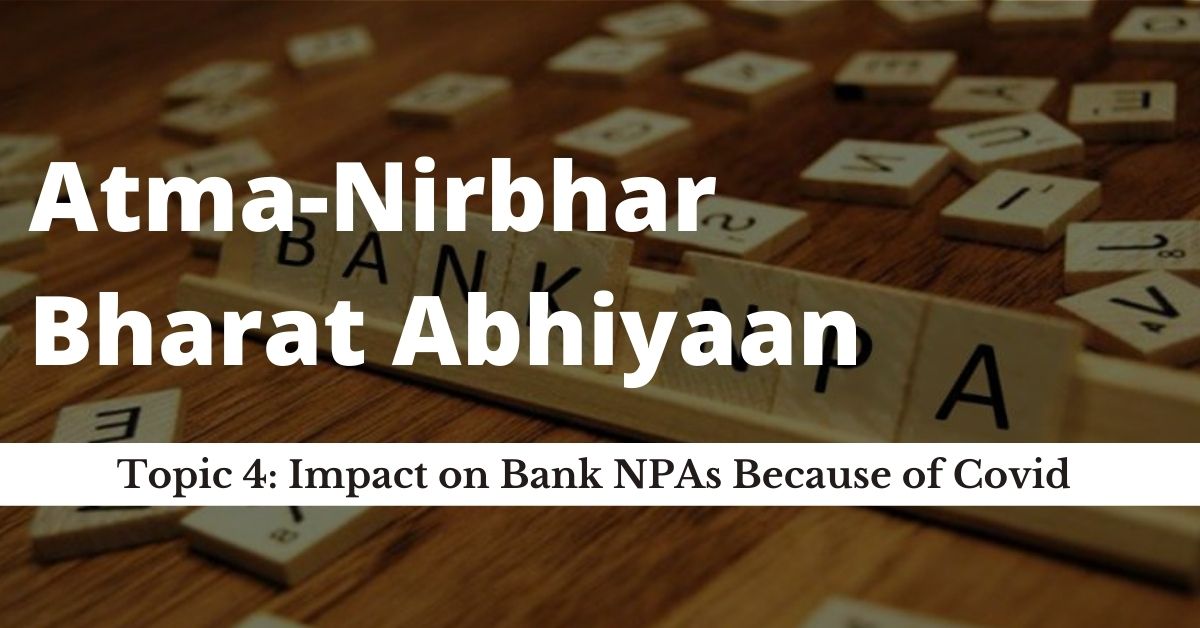Impact on Bank NPAs Because of Covid
July 27, 2020
Admin
Impact on Bank NPAs because of CovidBank NpaRbiBanking systemcovid19
In India, the RBI monitors the entire banking system and, as defined by the country's central bank, if for a period of more than 90 days, the interest or installment amount is overdue then that loan account can be termed a Non-Performing Asset.
The COVID-19 effect on the Indian economy, coupled with some of the schemes launched by the government to contain the problem may actually cause another wave of bad loans in the Indian banking system.
- Gross non-performing assets (NPAs) of banks are likely to worsen to 11.3-11.6% by the end of this financial year from 8.6% as of March 2020, due to disruptions caused by the coronavirus pandemic.
- Fresh gross slippages are estimated to be at 5-5.5% of standard advances during 2020- 21, which will increase the banks' credit provision and impact their earnings.
- With an increase in stress on asset quality and profitability, state-owned banks may need ₹45,000-82,500 crore of capital in this financial year under a weak credit growth scenario.
- The RBI moratorium to borrowers was extended by another three months till August 31, 2020, and asset quality stress is likely to be reflected only in the third and fourth quarters of 2020-21 results.
- While the lockdown has surely impacted the debt-servicing ability of borrowers, the extent of revival in economic activities as the restrictions are eased will drive the final impact on asset quality of banks.
- The credit provisions will continue to exceed the operating profits for the public sector banks (PSBs) during 2020-21, translating in a sixth consecutive year of loss.
- The lockdown is largely in effect in most parts of the country, this prolonged closure has paralyzed businesses and resulted in large-scale job losses which will have a corresponding impact on the bank NPAs.
- As part of the COVID-19 economic package, the Narendra Modi-led government has announced a series of loan schemes, some backed by government guarantees to small industrial units and non-banking finance companies (NBFCs). Of the Rs 20 lakh crore package, the direct spending is only about one percent of GDP, the rest include loans through various banking channels and development institutions.
- The coronavirus pandemic could not have come at a worse time for
- India’s banking sector, which is battling weak credit growth and trying to recover bad loans.
- Also, the macroeconomic prospects for India have worsened as many credit rating agencies have already started slashing its GDP targets for Q4FY20 and FY20.

Suggested Ways for NPA Mitigation:
- Securitization: A bank can bundle or pool the illiquid assets together into a special purpose vehicle (SPV, e.g., a trust), divide them into standardized amounts, and sell the claims of interest and principal payments as securities. Through Securitization, a bank can hedge both, Liquidity Risk and Credit Risk.
- Refinancing the Moratorium Period whereby increasing the Duration of the Loan and Interest-free Finance minus payment of EMI under COVID -19.
- In case, the corporate is an NPA, and the payment proceeds cannot be attained, *the Insolvency and Bankruptcy Code* may be triggered. It has the following steps:
- The main aim is to get at least the Principal of the loan back. What will IBA do, is as follows:-
- Step 1 of IBA is: The creditor or the borrower approaches the NCLT to carry out Bankruptcy proceedings.
- Step 2: An insolvency professional is hired to carry out the operation of the Insolvent Unit on behalf of the Creditors.
- Step 3:Within 180 days, the lenders have to come out of a concrete plan, and further 90 days may be given for the same.
- Step 4: If 75 % of lenders agree, then a plan may be made for debt restructuring otherwise after 180 days, the company’s assets may be liquidated.
Important Strategy to identify future trigger in Banking:
- Target the NIMs of banks to identify Net NPA to total assets and also identify the Liquidity Position of the Banks, implying if banks have Liquidity short- term Risks and also, their Net Interest Margins are lower, there is a * Future Trigger in an Indian Scheduled Commercial Bank*
How can banks prevent the future Net NPAs to Total Assets and also prevent the Liquidity Risks of Banks: If the Net Interest Margin as a percentage of Net Total Assets is between 2.76 to 3.08, then the profitability of the bank is within control. Lower the Net NPA to Total Assets, the greater are the Nims of banks.